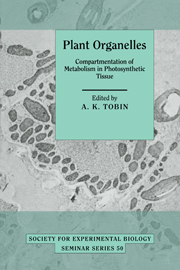Book contents
- Frontmatter
- Contents
- List of Contributors
- Preface
- Acknowledgements
- Metabolic interactions between organelles in photosynthetic tissue: a mitochondrial overview
- Metabolite transport in plant cells
- Metabolic interactions during photosynthetic and respiratory nitrogen assimilation in a green alga
- Carbon and nitrogen cycling between organdies during photorespiration
- Metabolic interactions between organelles in C4 plants
- Metabolic interactions in leaves of C3–C4 intermediate plants
- Metabolite compartmentation and transport in CAM plants
- Transport of H+, K+ and Ca2+ at the vacuolar membrane of plants
- Regulation of mitochondrial respiratory activity in photosynthetic systems
- Biosynthesis and assembly of the enzymes involved in lipid metabolism in plants
- The role of carnitine in plant cell metabolism
- Metabolic interactions of organelles in guard cells
- Transport of proteins into chloroplasts
- Metabolic interactions of organelles during leaf development
- Index
Transport of proteins into chloroplasts
Published online by Cambridge University Press: 05 December 2011
- Frontmatter
- Contents
- List of Contributors
- Preface
- Acknowledgements
- Metabolic interactions between organelles in photosynthetic tissue: a mitochondrial overview
- Metabolite transport in plant cells
- Metabolic interactions during photosynthetic and respiratory nitrogen assimilation in a green alga
- Carbon and nitrogen cycling between organdies during photorespiration
- Metabolic interactions between organelles in C4 plants
- Metabolic interactions in leaves of C3–C4 intermediate plants
- Metabolite compartmentation and transport in CAM plants
- Transport of H+, K+ and Ca2+ at the vacuolar membrane of plants
- Regulation of mitochondrial respiratory activity in photosynthetic systems
- Biosynthesis and assembly of the enzymes involved in lipid metabolism in plants
- The role of carnitine in plant cell metabolism
- Metabolic interactions of organelles in guard cells
- Transport of proteins into chloroplasts
- Metabolic interactions of organelles during leaf development
- Index
Summary
All cells transport proteins across membranes, but the complexity of protein traffic in plant cells is especially striking because of the variety of organelle types involved. Many proteins are inserted, during translation, into the lumen of the endoplasmic reticulum, after which they are transported via the endomembrane system to the Golgi apparatus, vacuole, protein bodies or plasma membrane. Other proteins are transported posttranslationally into glyoxysomes, mitochondria and plastids. In each case, the protein is synthesised with an appropriate signal which ensures targeting to the correct organelle, and a number of studies have attempted to define the characteristics of these targeting signals (reviewed by Bennett & Osteryoung, 1991; Robinson, 1991).
In terms of protein transport events, the biogenesis of the chloroplast is particularly complex, primarily owing to the architecture of the organelle. The chloroplast is bounded by a double-membrane envelope, between whose membranes is a soluble phase, the functions of which are presently obscure. Within the organelle is the soluble stromal phase (site of CO2 fixation, amino acid synthesis and many other key reactions) and the extensive internal thylakoid membrane. The thylakoid network also encloses a further soluble phase, usually termed the thylakoid lumen. Thus, the chloroplast comprises in total three distinct membranes and three discrete soluble phases. Most of the proteins located in each of these organellar compartments are encoded by nuclear genes, synthesised in the cytosol, and transported into the organelle. Clearly, therefore, chloroplast biogenesis requires both the specific, efficient targeting of a large number proteins into the organelle, and the operation of intraorganellar ‘sorting’ mechanisms to distribute imported proteins to their correct destinations.
- Type
- Chapter
- Information
- Plant OrganellesCompartmentation of Metabolism in Photosynthetic Tissue, pp. 281 - 292Publisher: Cambridge University PressPrint publication year: 1992



